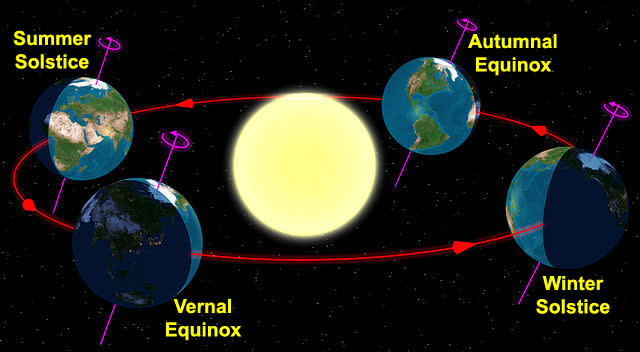 Science and Weather
Science and WeatherFirst day of spring: Myths and facts about the vernal equinox
Happy Vernal Equinox 2014!
At just about 12:57 p.m. Eastern Time today, March 20, 2014, the sun 'crossed over' Earth's equator, heralding the official arrival of spring for the Northern Hemisphere.
There's plenty of weird myths and cool facts about this time of year, and it's always a little bit of fun to go through some of them whenever these days swing around.
Myth: Day and night are equal on the equinoxes.
One of the most common things you may hear about the vernal equinox and its autumn 'partner' is that day and night are both exactly 12 hours long on that day. That's not quite true. The point where we crossed that threshold was actually a few days ago, on March 17, so by now, most places in the Northern Hemisphere already have a few minutes more than 12 hours of daylight.
The fact is, the equinox is defined as when the centre of the sun passes through the equator, but we don't count sunrise and sunset by that same measure. Sunrise is when the sun first pokes above the horizon and sunset is when it completely dips below the horizon. That means that the days where day and night are closest to 12 hours each will be before the spring equinox and after the fall equinox.
Myth: You can balance an egg on its end, but only at the precise moment of the equinox
This is another common myth about the equinoxes, and it even has a nugget of truth to it. You can balance an egg on its end at the precise moment of the equinox, but you can actually do that at any time of day or night, on any day of the year. It's not even easier to do it on the equinoxes. Success only depends on your own coordination and how 'bumpy' the end of the egg is.
Myth: If you stand on the equator during the equinox at noon, you don't cast a shadow
Standing at the equator, at noon on the day of the equinox will mean that the sun passes directly overhead of your location. That much is true. However, the fact is that you will still cast a shadow. It will just be straight down, so it'll be a rather small one, compared to other times of the year.
Myth: Earth tilts back and forth as it orbits the sun
This one may not be widespread, but it's worth going over. The Earth's pole is tilted (by roughly 23.3 degrees) with respect to our orbit around the sun, but the transitions between the seasons doesn't depend on the planet 'wobbling' back and forth like a top. In fact, the North Pole is pointed more or less towards the same point is space all year long (near the star Polaris), as is the South Pole (near the star Sigma Octantis). However, as shown in the image above, as the planet travels around the sun, the orientation of the planet means that the northern hemisphere is angled more towards the sun in the spring and summer, and the southern hemisphere is angled more towards the sun in fall and winter.
Just for the sake of completeness ... where the poles point does change periodically, due to what's known as precession. It's just that it doesn't happen on a yearly cycle, but rather a 26,000-year cycle.
[ More Geekquinox: NASA-backed study says human civilization is headed for irreversible collapse ]
Perhaps one of the thoughts that does creep into our minds around this time of year is that since this day means the end of the winter season, it's going to mean an end to the wintry weather as well. It's not so much a myth as just a hope, though.
It may be true in some areas of the world, but part of the reality of living in Canada's 'Great White North' is that regardless of what the calendar is telling you about the season, we can still have lots of ice and snow to perpetuate that feeling of winter. In fact, there are several places across the country today that are still experiencing wintry weather. The storm that passed through Ontario and Quebec yesterday is dumping a heap of snow over New Brunswick today, and the Prairies are getting a similar blast of snow, followed by some bitterly cold temperatures through the weekend.
By all accounts, it seems, this kind of weather is likely to last another month or so, at the least, and in many cases, that's probably a good thing. Record snowfall amounts in some places will need a long, slow melt to keep flooding from becoming a problem this spring.
(Image courtesy: Wikipedia)
Geek out with the latest in science and weather.
Follow @ygeekquinox on Twitter!



